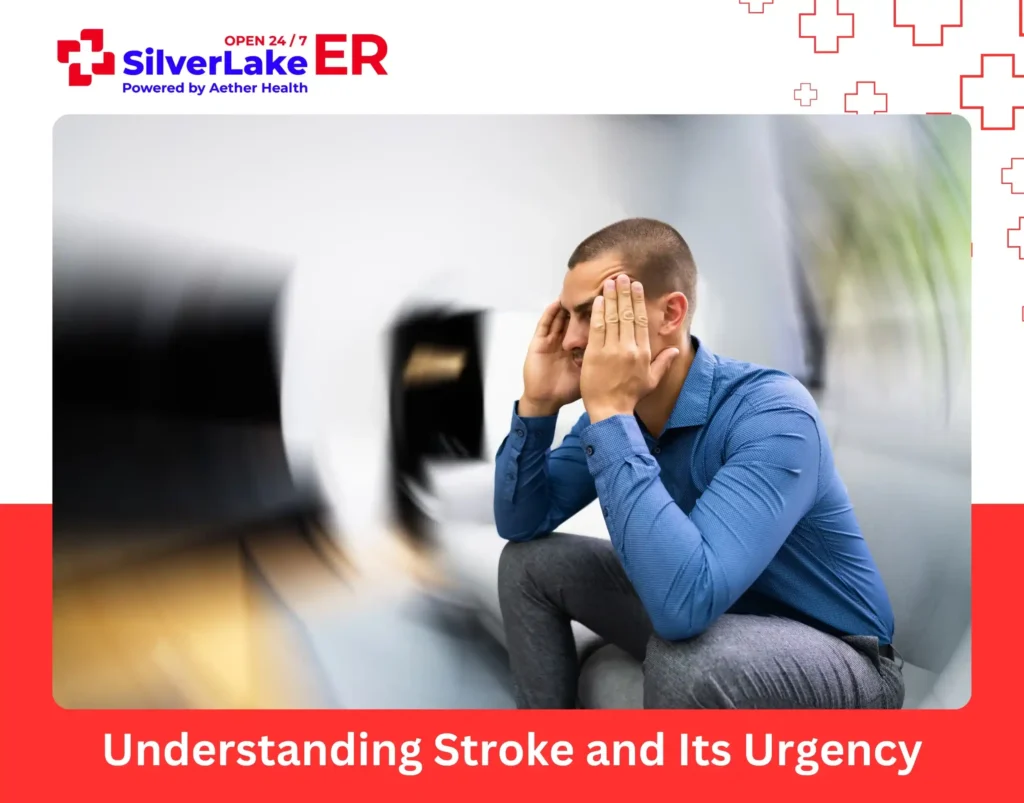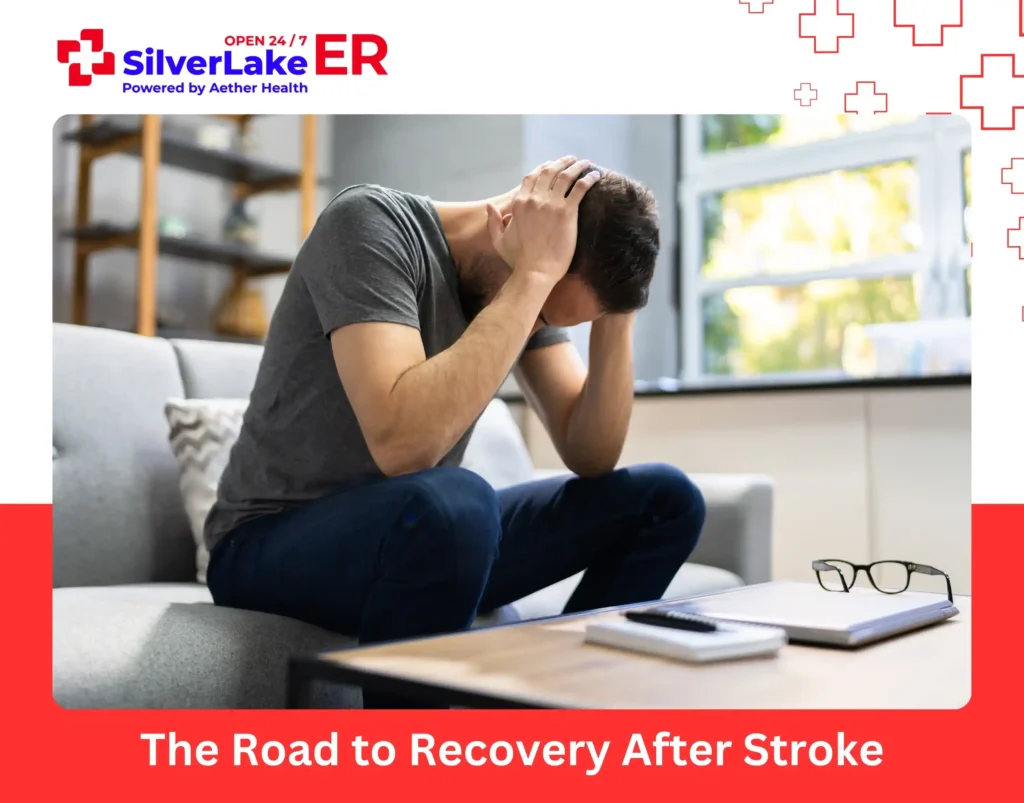A stroke cuts off blood flow to your brain without warning. Each passing second destroys thousands of brain cells, and the gap between full recovery and permanent disability shrinks rapidly as time passes.
At Silver Lake ER, our stroke treatment begins instantly upon arrival. Our emergency team utilizes advanced imaging and rapid-response treatment specifically designed to restore circulation before irreversible damage occurs.
The stroke treatment at Silver Lake prioritizes speed at every step, because delayed care can cost abilities that may never return.
Understanding Stroke and Its Urgency

A stroke is a life-threatening emergency that disrupts blood flow to the brain, either due to a clot (ischemic stroke) or a ruptured vessel (hemorrhagic stroke). Deprived of oxygen and nutrients, brain cells begin dying within minutes. These aren’t just cells; they’re your ability to speak, walk, or remember your grandchild’s name.
Recognizing stroke symptoms quickly can mean the difference between recovery and permanent disability. Let’s look at the warning signs that should prompt an immediate visit to the ER.
Recognizing Stroke Symptoms
The faster a stroke is identified, the sooner treatment can begin. The BE FAST method helps recognize the warning signs:
- Balance loss or dizziness
- Eyesight changes, such as blurred or double vision
- Facial drooping on one side
- Arm weakness or numbness
- Speech difficulties, confused or slurred speech
- Time to call 911 immediately
Even a brief delay can result in irreversible brain damage, making rapid treatment essential. Seeking care at a well-equipped emergency facility like Silver Lake ER ensures access to advanced stroke management, including clot-busting treatments and specialized neurological care.
Why Time Matters in Stroke Treatment

The phrase “time is brain” underscores the critical urgency of stroke care. With every passing minute, nearly 2 million brain cells are lost¹, increasing the likelihood of severe neurological damage. Swift medical intervention can significantly reduce the impact of a stroke and improve survival rates.
The Critical Treatment Window
Within the First 4.5 Hours:
- Ischemic strokes (caused by blood clots) can often be treated with tissue plasminogen activator (tPA), a powerful clot-dissolving medication.
- When administered within 4.5 hours of symptom onset, tPA helps restore blood flow, minimizing brain damage and enhancing recovery chances.
- Earlier administration leads to better functional outcomes, reducing the risk of paralysis, speech impairment, and cognitive decline.
Beyond 4.5 Hours:
- Patients with large artery blockages may benefit from mechanical thrombectomy, a minimally invasive procedure that physically removes the clot using a catheter.
- This intervention is most effective within 24 hours of stroke onset, but success rates are significantly higher when performed sooner.
- Rapid access to thrombectomy can mean the difference between independent living and severe disability.
The Devastating Consequences of Delayed Care
- Without prompt treatment, the stroke-affected area of the brain continues to deteriorate, leading to irreversible damage.
- Survivors of untreated or delayed stroke care face a higher risk of long-term paralysis, speech loss, memory impairment, and reduced quality of life.
- In severe cases, extensive brain damage can lead to fatal outcomes.
Seeking immediate stroke treatment at a fully equipped emergency facility, such as Silver Lake ER can significantly increase the likelihood of survival and complete recovery.
Advanced Stroke Treatment at Silver Lake ER
Every minute without treatment costs stroke patients 2 million brain cells. Our emergency teams at Silver Lake ER respond with urgency to this reality, providing critical interventions 24 hours a day that can preserve brain function and save lives.
What Sets Silver Lake ER Apart?
- Rapid Diagnostic Imaging – Immediate access to CT scans and PET scans enables our physicians to quickly distinguish between ischemic (clot-related) and hemorrhagic (bleeding) strokes. Once the doctors identify the stroke type, they begin the right stroke treatment strategy.
- Quick tPA Access – Patients with clot-based strokes who arrive within the treatment window receive tissue plasminogen activator promptly. This often reverses damage that would otherwise be permanent.
- Expert Coordination – We work closely with neurologists and stroke specialists throughout your care. For patients needing specialized procedures like mechanical clot removal, we arrange direct transfer to advanced treatment centers with no delays.
The Road to Recovery After Stroke

Most stroke recovery happens in the first 90 days when your brain actively rewires itself. The right therapies during this window can help reclaim functions you might initially lose, from arm movement to clear speech.
Your therapy team creates a personalized plan based on which brain areas were affected. They’ll push you just enough to stimulate healing without causing frustration.
Regular medical check-ups track your recovery progress and help manage underlying conditions like high blood pressure that could trigger another stroke.
Beyond the Silverlake ER
Silver Lake ER connects you directly with local stroke specialists and rehabilitation programs. We’ve built relationships with the best recovery teams in the area so your transition from emergency care to ongoing treatment happens smoothly.
Simple changes after discharge – heart-healthy diet, consistent medication, and following your exercise program – significantly reduce your chance of facing another stroke.
Many patients tell us recovery revealed strengths they never knew they had. The path isn’t easy, but with proper support, improvement continues long after leaving our doors.
FAQs
1. What is the golden period of a stroke?
The golden period of a stroke is the first 4.5 hours, during which timely treatment with clot-busting drugs or interventions can significantly reduce brain damage.
2. Can a person live 20 years after a stroke?
Yes, a person can live 20 years or more after a stroke, especially with proper rehabilitation, lifestyle changes, and medical management to prevent recurrence.
3. What is the most common cause of death after a stroke?
The most common cause of death after a stroke is neurological complications, such as brain swelling or herniation, followed by cardiovascular events like heart attacks or recurrent strokes




